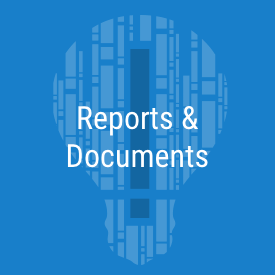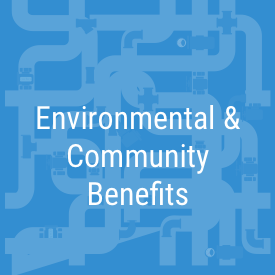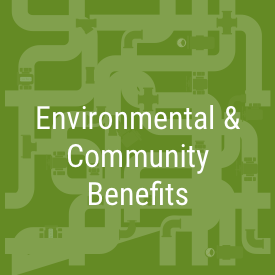This project creates a comprehensive watershed database that tracks stream ecosystem conditions helping Valley Water, other County agencies and organizations make informed watershed and asset management decisions. This new information integrates and enhances Valley Water’s stewardship actions through a standardized, repeatable and defensible approach that guides, organizes and integrates information on stream conditions. This ecological monitoring and assessment is conducted on an ongoing basis and is shared with land use agencies, environmental resource groups, and the public to support efficient restoration decisions throughout the county.








Key Performance Indicators for the Safe, Clean Water Program
KPI #1: Establish new or track existing ecological levels of service for streams in 5 watersheds.
-
Tracked existing ecological levels of service for streams in 5 watersheds using the California Rapid Assessment Method (CRAM), in partnership with the San Francisco Estuary Institute (SFEI). Click here for the Watersheds of Santa Clara Valley Click below to read:
Coyote Creek (2010), including Upper Penitencia Creek.
Guadalupe River (2012) urban and non-urban.
Lower San Francisco Bay peninsula creeks in Santa Clara County (2016), including San Francisquito, Adobe, and Stevens-Permanente creeks.
Pajaro River in Santa Clara County (2015), including Pacheco, Llagas, and Uvas creeks.
West Valley Watershed (2018), including Sunnyvale, Saratoga-San Tomas Aquino and Calabazas creeks.
-
Synthesis report of the Santa Clara County 5 watersheds (2020) summarizing ecological conditions, comparing watersheds to each other, statewide and San Francisco Bay Delta ecoregion. Ecological conditions measured by CRAM are shown for the County’s lowland valley, foothills, and headwaters. Examples applying CRAM to project and mitigation performance, and a watershed approach are provided.
- Go to EcoAtlas to see all CRAM results for creeks and river reaches, tidal marshes (estuarine wetlands and sloughs), depressional wetlands, and other locations. Create site reports that include CRAM results using EcoAtlas tools to identify ecosystem conditions at locations of interest.
-
2015 State of the Estuary overview poster: Stream health of the Coyote Creek and Guadalupe River watersheds using California's Wetland and Riparian Area Monitoring Plan (WRAMP).
KPI #2: Reassess streams in 5 watersheds to determine if ecological levels of service are maintained or improved.
- Field work to reassess the Coyote Creek watershed was completed in October 2020. Results will be posted on EcoAtlas this spring and the watersheds reassessment report available here this summer.
Updated April 2021
Related Information:
-
The Healthy Watersheds Partnership is devoted to monitoring and assessing the quality of California’s stream and river ecosystems, and bringing the resulting information to decision makers and the public.
-
2013 California Integrated Assessment of Watershed Health report by the US EPA Healthy Watersheds Protection.
-
2015 Perennial Streams Assessment (PSA) by CA State Water Resources Control Board, Surface Water Ambient Monitoring Program (SWAMP).
-
2015 California Stream Condition Index (CSCI) SWAMP stream health and CSCI Scores Map.
-
2015 California Central Coast Healthy Watersheds Project report card with trend analysis. For data and other information, see the Central Coast Regional Water Quality Control Board's Central Coast Ambient Monitoring Program (CCAMP), including the Pajaro River, Uvas-Carnadero and Llagas Creeks.
-
California Environmental Data Exchange Network (CEDEN) is a central location to find and share information about California’s water bodies, including streams, lakes, rivers, and the coastal ocean. CEDEN aggregates data and makes it accessible to environmental managers and the public.
- United States Geological Survey (USGS) California Stream Quality Assessment (CSQA)
Key Performance Indicators for the Safe, Clean Water Program
-
Establish new or track existing ecological levels of service for streams in 5 watersheds.
-
Reassess streams in 5 watersheds to determine if ecological levels of service are maintained or improved.
Benefits
-
Improves watershed and asset management decisions
-
Provides a systematic, scientific guide for decisions and actions to improve stream conditions
-
Supports effective design options for capital projects
-
Maximizes the impact of restoration dollars with more reliable data on countywide stream conditions
Geographic Area of Benefit
Countywide
About the Safe, Clean Water and Natural Flood Protection Program
In November 2012 the voters of Santa Clara County overwhelmingly approved Measure B, the Safe, Clean Water and Natural Flood Protection Program, as a countywide special parcel tax for 15 years with a sunset date of June 30, 2028. This Program replaced the Clean, Safe Creeks and Natural Flood Protection Plan, which voters approved in November 2000.
The Safe, Clean Water Program was developed with input from more than 16,000 residents and stakeholders and was created to match the community’s needs and values. The voters of Santa Clara County identified five priorities:
Priority A: Ensure a Safe, Reliable Water Supply
Priority B: Reduce Toxins, Hazards and Contaminants in our Waterways
Priority C: Protect our Water Supply from Earthquakes and Natural Disasters
Priority D: Restore Wildlife Habitat and Provide Open Space
Priority E: Provide Flood Protection to Homes, Businesses, Schools and Highways
Other: Six projects from the Clean, Safe, Creeks Plan have been carried forward into the Safe, Clean Water Program.
Each year, Valley Water prepares a report providing a progress update for each of these Program priorities, along with fiscal year accomplishments.
To ensure transparency and accountability to the voters, the ballot measure also created an Independent Monitoring Committee, appointed by the Santa Clara Valley Water District Board of Directors. The Independent Monitoring Committee annually reviews the Program’s progress to ensure the outcomes are achieved in a cost-efficient manner and reports its findings to the Board.
In addition, the Program requires three independent audits, the first of which was conducted in FY 2017.




